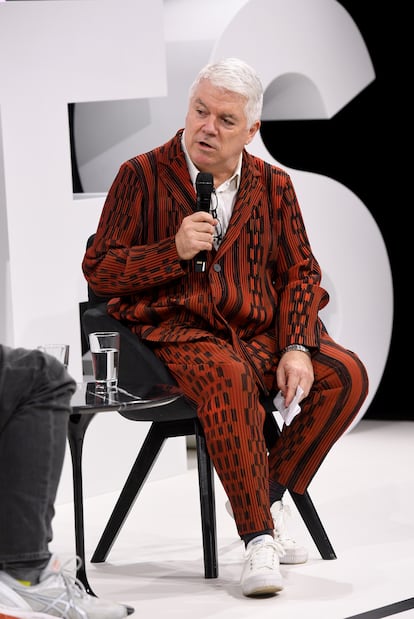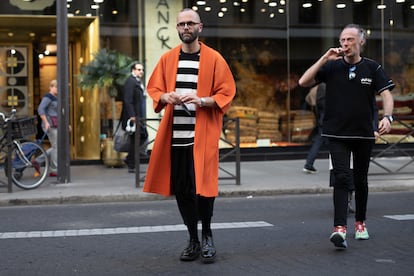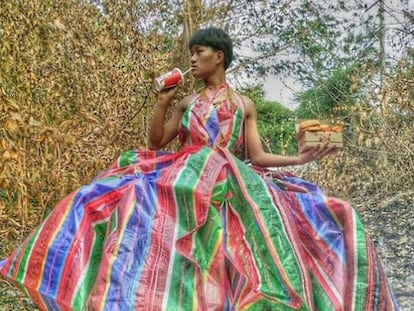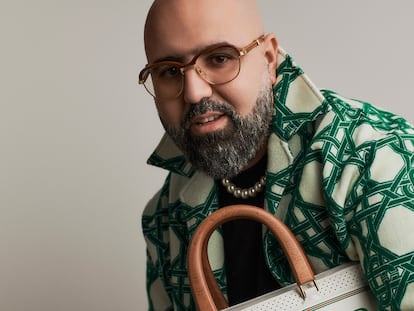How Issey Miyake’s clothing became the uniform of the creative class
From Steve Jobs to Zaha Hadid, the Japanese designer dressed a large group of loyalists who are averse to labels and attracted to the conceptual coherence (and comfort) of his pleated garments

There are designers who have clients, and designers who have devotees. Japanese designer Issey Miyake, who died on August 9 at the age of 84, was the latter. Moreover, his clientele is easy to spot. “Why are his clothes preferred by so many prominent figures in the arts?” art critic Herbert Muschamp wondered in his 1998 review of Miyake’s exhibition at the Fondation Cartier in Paris. He had every reason to ask.
For over two decades now, the soundtrack of openings, vernissages, roundtables and other events in the art world has consisted as much of clinking champagne glasses as the airy and technical rustling of Miyake’s pleated garments for women (since 1993, when he launched his Pleats Please line) and men (from 2013, when he created his Homme Plissé brand, adapting his bestselling clothes for men to wear). Gallerists, curators, architects, photographers, writers, journalists: few can resist the charms of pieces by the designer who best understood that the future of fashion went through the future of its fabrics. It’s fashion without logos, but instantly recognizable, just like Martin Margiela’s, another art circuit classic.
One doesn’t have to go to the red carpet to find Miyake’s garments, just observe everyday cosmopolitan cultural life. Over the decades, architect Zaha Hadid; designers Jonathan Anderson and Samuel Ross; fashion critics Tim Blanks, Suzy Menkes and Angelo Flaccavento; gallery owner Barry Friedman; artists Joana Vasconcelos and Graciela Iturbide, politician Carmen Alborch; and music icons Grace Jones and Joni Mitchell have all been seen wearing Miyake. Steve Jobs was also loyal to Miyake since he commissioned a turtleneck sweater and the Japanese designer responded with a hundred similar sweaters. In the years that followed, the Apple founder wore nothing else, according to his biographer, Walter Isaacson.
The idea of a uniform is a tantalizing hypothesis for explaining how quickly Miyake’s brand – which remains an independent company to this day – spread among certain groups. But there is an explanation – perfectly compatible with the previous one – that appeals to an earthlier reason: practicality. That was American architect and interior designer Rafael de Cárdenas’s assertion to Town & Country last April, after telling the magazine that he had discovered Miyake during his years as a designer at Calvin Klein. He said that the first time he wore Miyake, “my partner asked me if I was wearing my mom’s clothes. She’s big into the elegant sack thing. But it’s a good way to look smart when you’re actually wearing sweatpants.”

Comfort may well be one of the reasons for Miyake’s success. In the late 1980s, he began experimenting with a new way of pleating fabrics. That impulse to innovate wasn’t new. Since the beginning of his career, Miyake had been exploring the dialogue between technology and the old artisanal techniques of knitting and weaving. But he was more ambitious: instead of pleating the fabric prior to making the garment, he rolled and twisted the finished clothes, putting them into a machine that left the pleats indelibly marked by applying heat to the polyester. The pleating was irregular – it differed from garment to garment – as well as indestructible. As users say, the clothing can be put in the washing machine or haphazardly in a suitcase without fear of ruining the pleating. The result is pants, shirts, sweaters, jackets and dresses that weigh very little and use the shoulders as a hanger – the same logic that Cristóbal Balenciaga developed for separating clothes from the body by following the example of Japanese clothing – to project their volume outward.
At the same time, the silhouette the clothing generates is wide and light like the paper lamps of Isamu Noguchi, one of Miyake’s favorite designers. In an era dominated by sleek, elongated silhouettes, that horizontality could be unflattering, as art curator Antwaun Sargent emphasized in the same Town & Country article. He recalled that he’d associated Miyake with female collectors of a certain age. Then, he decided to buy a pair of pants after seeing Solange Knowles wear them; he has been loyal to the brand ever since. So has historian Roger Cook, who was interviewed for a feature on Miyake customers in The Financial Times when he was in his eighties. “The publicity for Plissé is primarily aimed at the youth or sport end of the market, but I feel it can be successfully and stylishly worn by seniors like myself,” he explained of his favorite baggy pants. “The enormous amount of bodily gratification I obtain from my Miyake wonderfully compensates for the depredations of old age.”
Miyake’s connection with the creative class has even found its way into marketing textbooks. In an article about “expertise marketing,” French professor – and Republican member of France’s National Assembly – Patrick Hetzel imagined Miyake’s prototypical client: her name is Josyane. She is a communications executive who works in the Parisian golden triangle and lives in the Marais; she views luxury fashion designers with skepticism and favors brands with sophisticated tastes, such as Miyake. “Josyane is proud of her 10 years of loyalty to the firm, which makes her part of a small tribe of people whose originality has served to create new styles,” Hetzel writes.

Although the example may be a cliché – after all, that’s what sociological textbook categorizations do – the Frenchman’s observation underscores another argument in Miyake’s favor: the artistic and conceptual pedigree he gained from decades of collaborating with the world of culture. Miyake is the designer of pleated clothing and the name behind two of the world’s most famous fragrances (L’Eau d’Issey and L’Eau d’Issey Pour Homme, which set the trend of aquatic fragrances in the 1990s). But he’s also a creator who has worked with William Forsythe, Yayoi Kusama and Cai Guo-Qiang; his collections have been featured in memorable photographs by Lord Snowdon, Irving Penn and Nick Knight; and since 1997, when he decided to step back from commercial designs to focus on experimental projects, his work has been featured in exhibits at the world’s most prestigious art centers. In some cases, both worlds have coexisted, as in the A-POC (A Piece of Clothing) project. The last commercial brand with which he was actively involved, the collection consisted of tubular fabrics that, thanks to computer technology, allowed each user to cut out their desired garment without worrying about fraying it.
Ultimately, Miyake’s work can be as intellectual or direct as one wants. Some of his biggest fans would say the latter. As fashion critic Tim Blanks told The Financial Times, “Don’t think about it [Miyake’s Homme Plissé]. Just put it on. Then we’ll talk.
Tu suscripción se está usando en otro dispositivo
¿Quieres añadir otro usuario a tu suscripción?
Si continúas leyendo en este dispositivo, no se podrá leer en el otro.
FlechaTu suscripción se está usando en otro dispositivo y solo puedes acceder a EL PAÍS desde un dispositivo a la vez.
Si quieres compartir tu cuenta, cambia tu suscripción a la modalidad Premium, así podrás añadir otro usuario. Cada uno accederá con su propia cuenta de email, lo que os permitirá personalizar vuestra experiencia en EL PAÍS.
¿Tienes una suscripción de empresa? Accede aquí para contratar más cuentas.
En el caso de no saber quién está usando tu cuenta, te recomendamos cambiar tu contraseña aquí.
Si decides continuar compartiendo tu cuenta, este mensaje se mostrará en tu dispositivo y en el de la otra persona que está usando tu cuenta de forma indefinida, afectando a tu experiencia de lectura. Puedes consultar aquí los términos y condiciones de la suscripción digital.
More information
Últimas noticias
Rowan Atkinson tops Netflix at 70: ‘He’s as funny as ever’
Israeli recognition of Somaliland stirs up the Gulf
Tiger Woods turns 50: Will he continue playing on the PGA Tour or take a back seat?
The surreal journey of James Nnaji, the Barcelona youth player selected in the NBA Draft who ended up in the NCAA
Most viewed
- Oona Chaplin: ‘I told James Cameron that I was living in a treehouse and starting a permaculture project with a friend’
- Reinhard Genzel, Nobel laureate in physics: ‘One-minute videos will never give you the truth’
- Sinaloa Cartel war is taking its toll on Los Chapitos
- Why the price of coffee has skyrocketed: from Brazilian plantations to specialty coffee houses
- Chevy Chase, the beloved comedian who was a monster off camera: ‘Not everyone hated him, just the people who’ve worked with him’











































